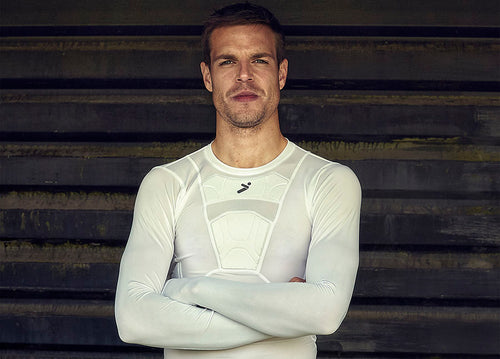
A little while ago, we put a spotlight on players who wear itty-bitty shin pads. They included the likes of Naby Keita, Dominic Calvert-Lewin, and Jack Grealish. As talented and admirable as these guys are, we were frank on our stance about mini shin pads—serious players should ditch them.
And now, several youth clubs in the U.K. have jumped on our bandwagon. In April, the BBC reported that grassroots football clubs are banning “mini” shin pads due to safety concerns. Being advocates for soccer safety, not to mention, being in the business of it, we think a ban on tiny shin pads is a smart move.
Here’s why.
Risks Associated with Wearing Tiny Shin Pads
Tiny shin pads are risky for a simple reason—they barely cover your shins. They can’t protect what they don’t cover.
We get that it’s trendy to play with socks rolled down, but style shouldn’t come a the expense of safety. Exposed areas of the shin are more likely to sustain bruising, lacerations, blunt trauma, and fractures.
Take a look at this and tell yourself if this actually makes sense.

Image Source: SPORTbible
Yeah, neither can we.
Jack Grealish, who we mentioned at the beginning of the article, is a victim of his own shin pad choices. Remember those persistent shin injuries he was battling a few seasons ago? Yeah—wearing those miniscule shin guards that sank to his ankles could have been the cause. They weren’t protecting his shins at all.
So take that as a lesson. It’s better to wear shin pads that offer full-coverage, instead of these tiny leg ornaments.
Current Guidelines on Shin Pads
The UK’s Football Association (FA), says that at the very least, a substantial portion of the shin should be covered. They recommend CE-marked shin pads since those ones meet safety standards set by regulatory bodies.
Now, we think players have escaped with tiny shin pads because there are no mandates for appropriate sizing. The rule has always been to just wear them.
But an FA spokesperson made the following comment:
“Shin pads play an important role in injury prevention as they are intended to protect the shin from injury.”
They went onto to make this crucial point.
"'Micro' or 'mini' shin pads may therefore increase the risk of injury due to the smaller amount of shin covered compared to larger sized shin pads."
Here in North America, the National Operating Committee on Standards for Athletic Equipment (NOCSAE), has a looser stance on shin pads right now. They’re mandatory for players to wear, but there are no restrictions on size.
Maybe in time, the NOSCAE will tighten up their rules and make stronger recommendations like the U.K.’s FA. Or maybe before that, there could be a similar movement where youth clubs ban mini shin pads before regulatory bodies do.
Reasons Why Players Wear Tiny Shin Pads
Modern design for sports apparel has a less-is-more aesthetic, a minimalistic to be exact. And it jives with the way players want to feel—light, unemcumbered, free.
That’s why it’s understandable when players make the following complaints:
- They’re uncomfortable and cause excessive sweating or itching in some cases.
- They hinder movement and make players feel less mobile or agile.
- They make players less aerodynamic.
- They look ugly and don’t fit the player’s fashion sense.
- They don’t offer much protection against injury in the first place.
These are legitimate complaints, but only if you’re wearing the wrong shin guards. Low-quality ones will absolutely feel like crap. But the right shin pads offer maximum protection with minimal distraction.
Storelli Shin Gaurds
Mini shin pads are unsafe and ineffective, yet bulky, oversized shin pads aren’t the answer either. There is a middle ground when it comes to this whole shin pad debacle. The best ones combine a lightweight and compact build, but are sturdy enough to withstand hard contact. They’re also flexible enough that they don’t feel restrictive.
Our line of Exoshield slip-in shin guards checks off those boxes. They’re lightweight, sporting a flexible shield, and coated with a high-strength resin. That shell and resin give the pads their strength so they can withstand blunt trauma.
They’re fitted with 8mm of molded padding, which flex to match the natural contours of your shin. That allows them to move with you, not against you.
They also prevent that sweaty feeling since they have air channels that allow your skin to breath and stay cool.
The slip-in shin guards fit perfectly in our leg guards, the latter of which has a pocket to keep the shin guards secure. The asymmetric wedge design of the shin pads acts like a latch, so they don’t slip and slide in your socks.
How to Encourage Players to Wear Normal Sized Shin Guards
We’ll make the assumption that most players are wearing appropriately-sized shin pads. But for the stubborn ones, some push is necessary.
First off, they need reminders on how delicate and injury-prone the shins are. Remind them of players like Jack Grealish who had recurring shin injuries due to wearing those teeny tiny shin pads.
If style and comfort is an issue, then point out some shin pads that offer full protection, but look—for a lack of a better word—cool. But of course, recommend pads that actually offer protection and feel good (get them to try it for fit).
Lastly, players have to remember they’re part of a team, and being a team player means adopting the team culture—safety rules included. A lax attitude towards safe play shouldn’t be welcome, and might only expose said players to injuries.
Looking for comfortable and high-quality, shin protection? Check out our new slip in shin guards to find your perfect fit!























